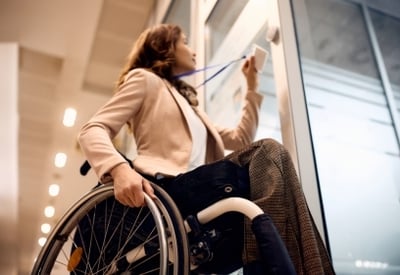Retailers and banks alike invest heavily in branch design, digital platforms and customer service. However, a surprising number still overlook one critical factor: whether everyone can actually access and use their services independently.
For today’s customers, accessibility is non-negotiable. It’s about creating a seamless experience for all customers, including people with accessibility needs. This extends to how they enter, navigate, interact with staff and complete transactions.
In this blog, we share a practical checklist that facilities and operations teams can use to assess whether their branches are truly accessible — and where hidden barriers may exist.
Why accessibility matters for retail and banking branches
Before we dive into the checklist, it’s worth underlining why accessibility is such a strategic priority.
Legal compliance
In most regions, accessibility is a legal requirement under equality and disability rights legislation. Failure to comply can lead to lawsuits, fines and reputational damage.
Customer base expansion
Over 1.3 billion people globally live with a disability – about one in six of us – representing a significant customer group with collective spending power. Making branches more inclusive helps capture this market.
Brand reputation
Accessibility reflects directly on brand values. Businesses seen as inclusive attract loyalty not only from disabled customers but also their families, carers and wider communities.
Operational resilience
Accessible design often improves experiences for all customers. Features like clear signage, intuitive layouts and step-free entry benefit parents with prams, older adults and people recovering from surgery.
The branch accessibility checklist
Step 1: Entryways and exterior access
First impressions matter, and for many customers, the accessibility journey begins before they even walk through the door. Consider:
- Are there clearly signposted accessible parking bays close to the entrance?
- Is the entrance step-free or equipped with a ramp or lift that complies with accessibility standards?
- Are doors automatic, lightweight or fitted with accessible handles?
- Is the exterior lighting adequate for people with low vision, particularly during evening hours?
Step 2: Navigation inside the branch
Once inside, customers should be able to move freely and comfortably. Barriers often arise when facilities aren’t designed with mobility in mind.
- Are aisles wide enough for wheelchair users and people using mobility aids?
- Is the flooring smooth, slip-resistant and free from clutter?
- Are queueing systems designed with clear pathways and priority spaces?
- Are there rest areas or seating available for those who may struggle to stand for long periods?
Here, accessibility is as much about operational planning as it is about design. Even a well-laid-out space can become inaccessible if staff leave boxes, promotional stands or other obstructions in key pathways.
Step 3: Signage and communication
Clear, inclusive signage is a hallmark of accessible branches. It ensures customers can navigate independently and reduces pressure on staff to provide constant guidance.
- Are signs displayed at multiple heights to ensure visibility from seated and standing positions?
- Do signs use high-contrast colours, large fonts and simple wording?
- Are tactile or braille options available where needed?
- Is wayfinding supplemented with digital or audio cues where possible?
Inclusive communication should also extend to interactions between staff and customers. For example, staff should be trained to assist customers who are deaf, hard of hearing or neurodiverse, using simple and respectful communication practices.
Step 4: ATMs, kiosks and service counters
Banking and retail branches increasingly rely on self-service technology. But if ATMs, kiosks or check-in systems aren’t designed inclusively, they can create significant barriers.
- Are ATMs positioned at a height accessible to wheelchair users?
- Do machines provide tactile keys, audio output and screen reader compatibility?
- Are service counters fitted with hearing loops for customers with hearing impairments?
- Do digital kiosks offer multiple input options (touchscreen, keypad, voice commands)?
Inaccessible technology not only excludes disabled customers but can also slow down operations as staff intervene to provide manual support.
Step 5: Appointment booking and customer flow
Accessibility doesn’t begin and end at the branch doors. It extends to how customers plan and manage their visits.
- Is appointment booking available online and designed to be accessible (screen reader compatibility, easy navigation)?
- Can customers indicate accessibility needs when scheduling appointments?
- Are waiting areas equipped with accessible seating and clear digital displays?
- Do customer service processes respect privacy while ensuring support for people who need assistance?
Step 6: Toilets and additional facilities
Not every branch provides public restrooms, but where they exist, accessibility is critical.
- Are accessible toilets provided, clearly signposted and regularly maintained?
- Do they comply with local accessibility standards, including grab rails, emergency alarms and adequate turning space?
- Are baby changing facilities inclusive, considering both parents and carers with different needs?
Neglecting these facilities can significantly affect customer experience, particularly for parents, older adults and disabled customers.
Common hidden barriers
Even when the basics are in place, hidden barriers can persist. These might include:
- Poor acoustics that make communication difficult for people with hearing loss.
- Overly complex signage that overwhelms neurodiverse individuals.
- Heavy manual doors in internal areas like toilets or stairwells.
- Inconsistent staff training, leading to uneven customer support.
Small adjustments can make a big difference. For example, training staff to proactively offer assistance, or ensuring background music is kept at a reasonable level, can improve accessibility for many customers.
Taking the first step: Accessibility as a brand advantage
Assessing branch accessibility can feel daunting, but breaking it into practical steps makes it manageable. Mobility Mojo’s self-assessment tool is a great place to begin, offering a quick snapshot of where you stand and where improvements are most urgent.
From there, a full assessment can provide a comprehensive view, helping businesses meet legal standards, reduce risk and create welcoming environments for all.
By taking accessibility seriously, businesses send a powerful message.
We value all our customers equally.
Accessibility enhances brand reputation, builds customer loyalty and positions businesses for long-term resilience. The investment pays off through stronger customer relationships, increased footfall and enhanced trust.
For further practical insights and takeaways, we recommend exploring the Disability:IN Enclusive Takeaways guide. It’s packed with actionable advice on making retail spaces more inclusive and provides a strong benchmark for businesses ready to take the next step.
-1.png?width=720&name=Untitled%20design%20(3)-1.png)

/curves%20(4).png?width=720&height=720&name=curves%20(4).png)
-1.png?width=450&height=275&name=Untitled%20design%20(3)-1.png)


/man-with-service-dog.jpg?width=720&name=man-with-service-dog.jpg)
/curves.png?width=720&height=720&name=curves.png)